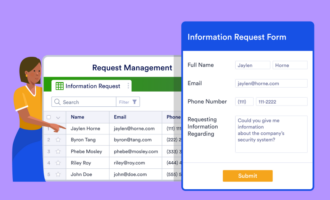Implementing an incident management process
- Define and implement specific processes
- Identify incident alerts
- Educate and train employees
- Maintain open communication
- Implement change processes
- Leverage automation
Many industries use incident management for everything from worker safety to system maintenance.
It’s critical to have a system in place before someone detects a problem. An established incident management process ensures that everyone follows the same protocols for documenting and addressing the circumstances of an incident, reducing the impact on the business.
What is incident management?
Incident management is a process that organizations use to respond to service interruptions, unplanned events, or accidents. Any time a situation occurs that disrupts operations or requires an emergency response, the team should follow an established process to manage potential issues.
Not only are these processes helpful for incident response, but proactive processes can also help in detecting and investigating problems at the earliest stages.
Incidents vary in severity, with small problems causing a minor disruption and major problems causing severe, long-term consequences.
Why incident management is important
Good incident management processes ensure that the IT department can quickly respond to known issues. This fast response is essential to decrease the overall impact of each incident. In addition, an effective system and prompt response mitigate damage and keep business operations functioning whenever possible.
On the other hand, weak incident management can cause serious setbacks for your organization. For example, you might have productivity issues, lose revenue, or lose important data. Even minor incidents need prompt attention and a thorough investigation to identify and correct problems.
Here are just a few benefits that come when you implement an incident management process:
- Avoid preventable incidents.
- Decrease the time it takes to resolve incidents.
- Eliminate or reduce downtime after an incident.
- Protect data and files.
- Improve customer satisfaction.
- Reduce costs and financial impact.
Tips for implementing an incident management process
Where should you start when you want to implement new strategies or improve your current processes? Follow these tips to ensure a successful outcome for your organization.
- Define and implement specific processes. As you document your incident management processes, consider the most common vulnerabilities in your organization. Documenting these vulnerabilities and processes is critical to ensuring consistent implementation going forward.
- Identify incident alerts. Determine the way events should be categorized and when the system should trigger alerts. It’s helpful to start by identifying specific indicators for your services. Then create built-in notifications that alert the IT team if something is outside these parameters.
- Educate and train employees. Once your processes are ready, the next step is to train employees on the processes they should follow when incidents occur. In addition, staff members need to know how to identify and report incidents to the IT team to ensure a timely response.
- Maintain open communication. Set clear guidance on communication expectations, such as the type of communication required and specific platforms employees should use. Incident communication is critical to help team members pass along details accurately and reduce the risk of misinformation.
- Implement change processes. Not only do you need a prompt response to correct immediate problems, but it’s also critical to be proactive about implementing changes to prevent future issues. It’s helpful to have built-in approvals in this step, so management or other team members can review and approve these changes to avoid damages in the future.
- Leverage automation. Don’t rely on manual processes for incident management. Instead, look for ways to use automation whenever possible. Automation can flag potential issues that might otherwise go unnoticed.
The key to a successful incident management system is to ensure your processes are custom-designed to fit your organization’s unique needs.
Management and automation solutions from Jotform
Jotform is an ideal solution for automating incident management processes. IT departments can use forms to collect incident information and then manage and track the data through Jotform Tables, offering transparency for all stakeholders. Additionally, Jotform Approvals automates any incident processes that require approval.
This three-step system covers everything you need for an effective incident management process. You can choose from predesigned forms and table templates or create forms and tables from scratch to create the ideal system that supports your organization — now and in the future.
Photo by Karolina Grabowska














































































Send Comment: